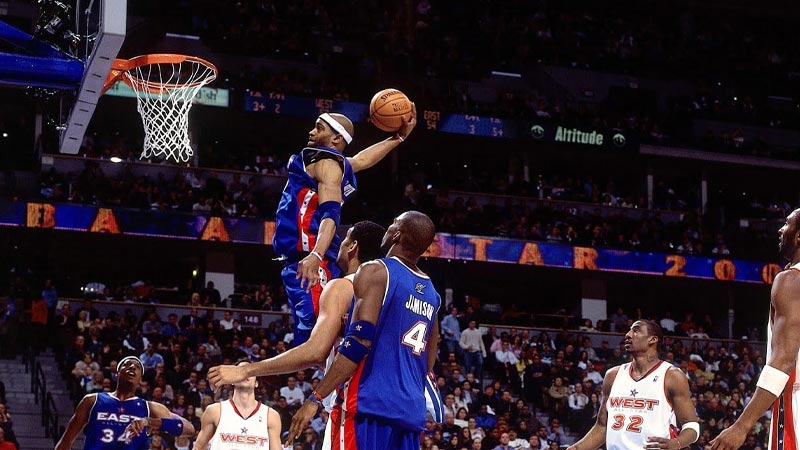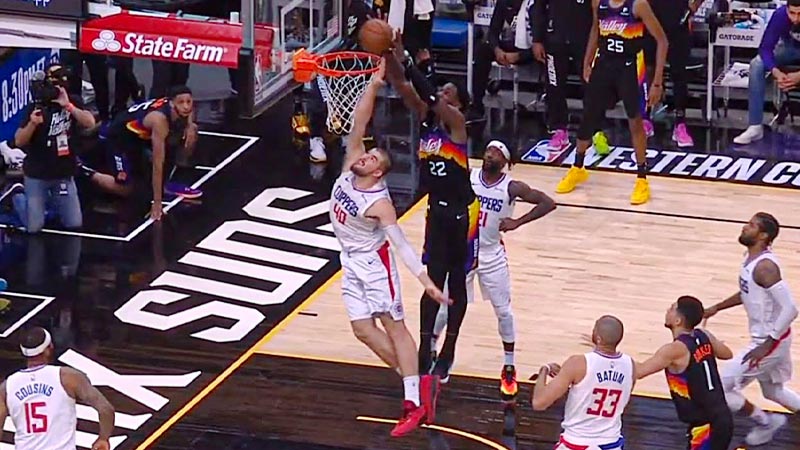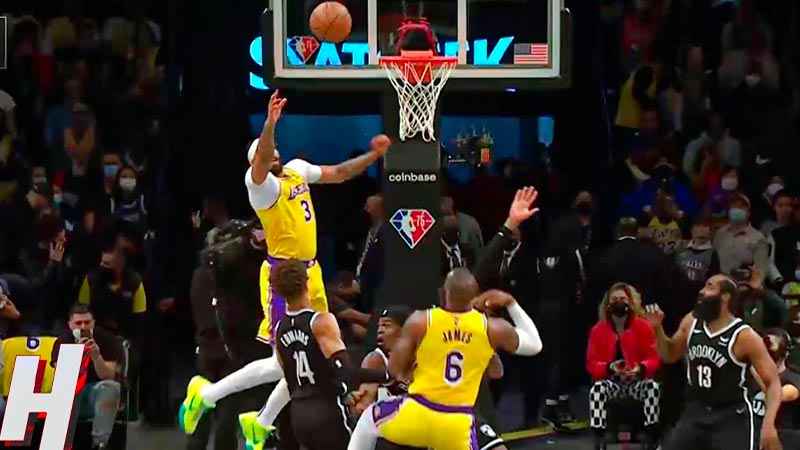Basketball is a sport that has captivated audiences around the world with its fast-paced action and gravity-defying moves. From thunderous dunks to pinpoint passes, the game is filled with breathtaking displays of athleticism.
One such maneuver that has become synonymous with basketball excitement is the alley-oop. But what exactly is an alley-oop in Basketball?
In its essence, an alley-oop is a spectacular play that involves one player throwing the ball toward the basket while another player catches it mid-air and dunks it before touching the ground.
Over time, it found its way into basketball lingo and now represents one of the most electrifying plays in the game.
With its combination of timing, athleticism, and teamwork, the alley-oop has become a highlight-reel staple, leaving fans in awe and players on the receiving end of the pass basking in the glory of their gravity-defying feats.
This article will explore the alley-oops definition, history, and significance in basketball. Join us as we unravel the captivating world of the alley-oop, where gravity is defied and the boundaries of human athleticism are pushed to the limit.
What Is An Alley Oop In Basketball?
An alley-oop is a dynamic and exciting basketball play involving one player throwing the ball high above the rim to a teammate, who catches it mid-air and dunks or finishes with a layup.
This impressive maneuver is often executed in a fast-paced, coordinated manner, showcasing teamwork, timing, and athleticism.
An alley-oop is a play in which one player passes the ball to another player who catches it in mid-air and dunks it or lays it in before landing.
The term comes from the French expression “allez hop,” which means “let’s go” or “up you go.” An alley-oop requires precise timing, coordination, and athleticism from both the passer and the receiver.
Different types of alley-oops depend on the situation and the players involved. Some of the most common ones are:
- The backdoor alley-oop occurs when the receiver cuts behind the defender and receives a lob pass over the top for an easy finish.
- The pick-and-roll alley-oop occurs when the receiver sets a screen for the passer and then rolls to the basket, where he gets a high pass for a dunk or a layup.
- The fast break alley-oop occurs when the passer leads a quick break and throws a long pass ahead to the receiver, who runs ahead of the defense and catches it for a slam.
- The self-alley-oop occurs when the passer bounces the ball off the backboard or the rim and then catches it himself for a dunk. This is also known as an off-the-glass alley-oop.
An alley-oop is one of the most exciting plays in basketball because it showcases the players’ skill, creativity, and teamwork. It also energizes the crowd and demoralizes the opponents.
However, it also involves high risk and difficulty, as a bad pass or a missed catch can result in a turnover or an injury. Therefore, an alley-oop should only be attempted by experienced and confident players who have practiced it well.
How Does The Alley-Oop Works?

The alley-oop is a spectacular basketball play involving a passer throwing the ball near the basket for a teammate to catch and dunk or lay it up in one fluid motion. It requires precise timing, coordination, and athleticism to execute successfully.
Explanation Of The Basic Alley-Oop Concept:
The basic alley-oop concept revolves around the passer and the receiver working together to create a scoring opportunity. The passer throws a high, arcing pass near the basket while the receiver times their jump to catch the ball mid-air and finish the play with a powerful dunk or layup.
The alley-oop is often used as a strategic offensive maneuver to surprise the defense and energize the team and crowd.
Roles Of The Passer And The Receiver:
The passer in an alley-oop play must have good court vision and passing skills. They must accurately read the situation, assess the defense’s positioning, and deliver a well-timed and well-placed pass.
Conversely, the receiver must have excellent leaping ability, timing, and hand-eye coordination. They need to anticipate the key, time their jump perfectly, and have the skill to finish the play at the rim.
Timing And Coordination Required For A Successful Alley-Oop:
Timing and coordination are crucial for a successful alley-oop. The passer must release the ball immediately, allowing the receiver enough time to catch and finish the play.
The receiver must synchronize their jump with the pass, ensuring they are in the air when the ball arrives. Effective communication and understanding between the passer and the receiver are vital to achieving the desired result.
Variations And Improvisations Of The Alley-Oop Play:
Over time, basketball players and teams have developed various variations and improvisations of the alley-oop play. These include alley-oops off the backboard, lob passes from behind the three-point line, and alley-oops initiated by dribble penetration.
These adaptations add creativity and excitement to the play, making it even more challenging for the defense to anticipate and defend against.
The Execution Of An Alley-Oop

Alley-oops are spectacular and high-flying plays in basketball that require precise coordination between the passer and the receiver. This thrilling maneuver involves one player throwing a pass near the basket.
In contrast, another player jumps to catch the ball mid-air and finishes the play with a dunk or layup. Successful execution of an alley-oop involves several critical factors and roles.
Preparing For The Alley-Oop
Setting up the play begins with the team’s offensive strategy and coordination. Players must communicate effectively to ensure everyone understands their roles and responsibilities.
Proper positioning on the court is crucial for creating passing lanes and providing the receiver with enough space to complete the play.
The Passer’s Role
The passer plays a pivotal role in the alley-oop. They must create space by drawing defenders away from the intended receiver. Reading the defense is essential to decide whether to throw the alley-oop or make an alternative play. Finally, the passer must deliver an accurate pass that allows the receiver to catch the ball smoothly.
The Receiver’s Role
The receiver’s timing and positioning are crucial for a successful alley-oop. They must time their jump perfectly to meet the pass mid-air, maximizing the chance of completing the play.
Utilizing athleticism and vertical leaps enables the receiver to elevate above defenders and make the catch. Once in possession of the ball, the receiver must finish the play with a powerful dunk or a well-executed layup.
Impact Of The Alley-Oop On The Game Of Basketball

The alley-oop, a high-flying and visually captivating play, has significantly impacted the game of basketball, revolutionizing crowd engagement, momentum shifts, athleticism showcases, and offensive strategies.
Crowd Engagement And Excitement
The alley-oop has become one of basketball’s most exhilarating and crowd-pleasing aspects. When a player launches the ball towards the hoop and another leap to catch and slam it in, spectators are electrified by the sheer spectacle and unpredictability of the play.
The alley-oop serves as a catalyst for roaring cheers, standing ovations, and increased fan involvement, enhancing the game’s overall atmosphere.
Momentum-Shifting Plays
An alley-oop can instantly swing the momentum in favor of the team executing it. When completed, it injects energy and confidence into the players, demoralizing the opposition and igniting a spark in the team’s performance.
Momentum-shifting alley-oops can shift the tide of a game, leading to scoring runs, defensive intensity, and renewed determination.
Showcase Of Athleticism And Teamwork:
The alley-oop epitomizes the athleticism and coordination required in basketball. It showcases the incredible vertical leap and timing of the player catching the pass, as well as the precision and court vision of the passer.
Successful alley-oops demonstrate the seamless teamwork and chemistry between teammates, emphasizing the importance of trust, communication, and synergy on the court.
Influence On Offensive Strategies And Tactics:
The alley-oop has had a profound influence on offensive strategies and tactics. Teams often incorporate alley-oop plays into their game plans to exploit height advantages, capitalize on fast breaks, and create scoring opportunities near the rim.
Defenses must adjust by deploying strategies to disrupt or anticipate alley-oop attempts, altering their positioning and defensive rotations. The alley-oop forces offensive and defensive teams to adapt and innovate, adding depth and complexity to the game.
Famous Alley-Oop Moments In Basketball History
Alley-oops are one of the most exciting and crowd-pleasing plays in basketball. They require precise timing, coordination, and athleticism between the passer and the receiver. Throughout the history of the sport, there have been several memorable alley-oop moments that have left fans in awe.
Examples from the NBA
The “Lob City” Era Of The Los Angeles Clippers:
During the early 2010s, the Los Angeles Clippers, led by Chris Paul, Blake Griffin, and DeAndre Jordan, became known for their spectacular alley-oop plays.
The combination of Paul’s exceptional court vision and the high-flying athleticism of Griffin and Jordan resulted in numerous highlight-reel dunks that electrified the crowd.
Lebron James And Dwyane Wade’s Alley-Oop Connections:
LeBron James and Dwyane Wade formed a dynamic duo during their time with the Miami Heat. Their chemistry and athleticism led to countless breathtaking alley-oop plays, with James often throwing pinpoint passes to Wade for thunderous finishes above the rim.
Their alley-oop connections became a trademark of their partnership. They added to their legacy as two of the game’s greatest players.
Vince Carter’s Iconic Dunk In The 2000 NBA Slam Dunk Contest:
In what is widely regarded as one of the greatest moments in Slam Dunk Contest history, Vince Carter showcased his otherworldly athleticism with a jaw-dropping alley-oop dunk.
With his head reaching the rim, Carter threw down a reverse 360-windmill dunk, leaving spectators and fellow players in disbelief. The dunk solidified Carter’s status as one of the most electrifying players in NBA history.
FAQs
What is the origin of the term “alley-oop”?
The term “alley oop” comes from the French expression “allez hop”, which means “let’s go” or “up you go”.
Who typically performs the alley-oop?
The alley-oop is usually executed by a passer or playmaker who throws the ball, known as the “lob,” and a leaping teammate who receives it, known as the “finisher.”
What is the purpose of an alley-oop?
The alley-oop is a high-percentage scoring opportunity, combining athleticism, coordination, and timing. It is intended to excite the crowd, demoralize opponents, and energize the team.
Are alley-oops legal in basketball?
Alley-oops are legal as long as they are executed within the game’s rules. After receiving the ball, the lob must be released before the passer’s feet touch the ground.
How did the alley-oop evolve in basketball?
The alley-oop has evolved from a simple lob pass to various creative and complex plays. Today, players employ misdirection, off-the-backboard passes, and even self-alley-oops, showcasing the innovation and artistry within the game.
Conclusion
The alley-oop has cemented its status as a defining moment in basketball. Its definition as a high-flying play where one player lobs the ball to a teammate for a spectacular slam dunk showcases the athleticism and teamwork that define the sport.
Over the years, the alley-oop has evolved and adapted. Still, its enduring relevance lies in its ability to captivate fans and leave lasting memories.
The alley-oop represents the intersection of excitement and artistry, a testament to the creativity and skill that make basketball an exhilarating spectacle.







